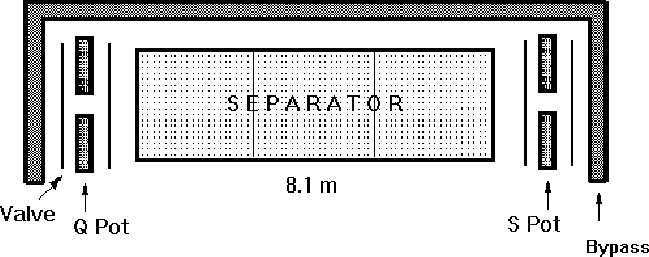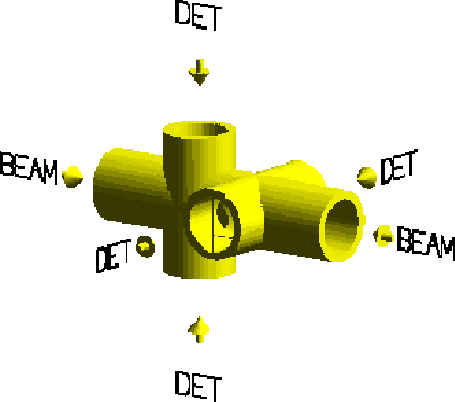 The details of the modifications are discussed in Sec. 6.
The details of the modifications are discussed in Sec. 6.
There is currently no space for Roman pots except for the dipole
spectrometer pots ![]() and
and ![]() .
The instrumentation of both the outgoing proton and
anti-proton arms requires modifications to
the machine lattice to create space for the detectors.
The proposal here involves moving the three low
beta quadrupoles on each side (
.
The instrumentation of both the outgoing proton and
anti-proton arms requires modifications to
the machine lattice to create space for the detectors.
The proposal here involves moving the three low
beta quadrupoles on each side (![]() ,
, ![]() , and
, and ![]() )
about two-thirds of a meter closer to the interaction region, in order
to create two one-third meter spaces for the Roman pot stations.
Roman pots would be located
at either end of the electrostatic separators, which would be moved one-third
meter closer to the interaction region.
Figure 9 shows
a sketch of the proton-side separator with Roman pots inserted.
The area within the bypass is the
only ``warm'' section of beam pipe
in reasonable proximity to the DØ detector, and is thus the obvious
choice for the location of Roman pots.
)
about two-thirds of a meter closer to the interaction region, in order
to create two one-third meter spaces for the Roman pot stations.
Roman pots would be located
at either end of the electrostatic separators, which would be moved one-third
meter closer to the interaction region.
Figure 9 shows
a sketch of the proton-side separator with Roman pots inserted.
The area within the bypass is the
only ``warm'' section of beam pipe
in reasonable proximity to the DØ detector, and is thus the obvious
choice for the location of Roman pots. The details of the modifications are discussed in Sec. 6.
The details of the modifications are discussed in Sec. 6.

Figure 9: A sketch of the electrostatic separator
on the proton side with Roman pots inserted. The pots
will be isolated from the separator by a vacuum valve
on either side.
The FPD thus will consist of six Roman pot stations, the
aforementioned ![]() , which has two stations,
plus four stations that use
the quadrupole magnets to measure the proton (
, which has two stations,
plus four stations that use
the quadrupole magnets to measure the proton (![]() and
and ![]() ) or
anti-proton (
) or
anti-proton (![]() and
and ![]() ) trajectory instead of the dipole magnets.
) trajectory instead of the dipole magnets.

Figure 10: The ``Cross'' design of the beam pipe which allows Roman pots
in the horizontal and vertical planes. There will be four detectors
(``DET'') per quadrupole station.
The entire beam pipe section
will only be about 12 inches long.
An ideal proton detector would be an annular detector with full ![]() acceptance close to the beam. Since it is necessary to remove the detector
during injection of the beam for stability and radiation considerations,
such a design is impractical. Typically Roman pot stations have
consisted of pairs of pots in either the horizontal or vertical plane, which
generally provide adequate but not optimal acceptance. We are proposing
a ``cross'' design (see Fig. 10),
which maximizes the acceptance for protons and anti-protons
by allowing pots in both the horizontal and vertical planes.
acceptance close to the beam. Since it is necessary to remove the detector
during injection of the beam for stability and radiation considerations,
such a design is impractical. Typically Roman pot stations have
consisted of pairs of pots in either the horizontal or vertical plane, which
generally provide adequate but not optimal acceptance. We are proposing
a ``cross'' design (see Fig. 10),
which maximizes the acceptance for protons and anti-protons
by allowing pots in both the horizontal and vertical planes.
With this ``cross'' design there are eight independent
quadrupole spectrometers,
four on each side of the interaction region (two each in the x and
y directions). This gives a total of 18 pots, 2 dipole pots and 16
quadrupole pots. An example of a quadrupole spectrometer is
the ![]() spectrometer (first proton spectrometer) shown in Fig. 8,
which has the pot
spectrometer (first proton spectrometer) shown in Fig. 8,
which has the pot ![]() located after the
located after the ![]() quadrupole
about 23 m from the interaction point, and
quadrupole
about 23 m from the interaction point, and ![]() located about 31 m from z=0.
A proton deflected to the left of the beam axis
would be detected in this spectrometer while
a proton scattered to the right would be detected in the
located about 31 m from z=0.
A proton deflected to the left of the beam axis
would be detected in this spectrometer while
a proton scattered to the right would be detected in the ![]() spectrometer in
pots
spectrometer in
pots ![]() and
and ![]() . There would also be
. There would also be ![]() and
and ![]() spectrometers
(not shown in Fig. 8 for simplicity)
for protons scattered above and below the beamline.
Analogous spectrometers are located on the anti-proton side.
spectrometers
(not shown in Fig. 8 for simplicity)
for protons scattered above and below the beamline.
Analogous spectrometers are located on the anti-proton side.
Although studies (discussed in Sec. 6) must be completed to show the feasibility of moving the quadrupole magnets, the implementation of this entire proposal provides a vast improvement over the dipole spectrometer alone. The gains are as follows